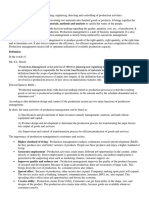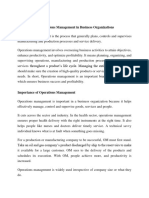0 ratings0% found this document useful (0 votes)
5 viewsProcess Excellence (N)
Process Excellence (N)
Uploaded by
Srangarajan SrinivasaCopyright:
© All Rights Reserved
Available Formats
Download as DOCX, PDF, TXT or read online from Scribd
Process Excellence (N)
Process Excellence (N)
Uploaded by
Srangarajan Srinivasa0 ratings0% found this document useful (0 votes)
5 views2 pagesOriginal Title
process excellence(n)
Copyright
© © All Rights Reserved
Available Formats
DOCX, PDF, TXT or read online from Scribd
Share this document
Did you find this document useful?
Is this content inappropriate?
Copyright:
© All Rights Reserved
Available Formats
Download as DOCX, PDF, TXT or read online from Scribd
Download as docx, pdf, or txt
0 ratings0% found this document useful (0 votes)
5 views2 pagesProcess Excellence (N)
Process Excellence (N)
Uploaded by
Srangarajan SrinivasaCopyright:
© All Rights Reserved
Available Formats
Download as DOCX, PDF, TXT or read online from Scribd
Download as docx, pdf, or txt
You are on page 1of 2
rocess Design in Operations Management:Process Design in Operations Management:
Definition: Process design is the act of developing or optimising mechanisms whereby
inputs are turned into outputs Understand. That is why knowledge of how work is
done inside an organisation and how it is performed is critical together with
identifying how such performance may be improved.
Importance: The most effective pattern of organizing work flow enhances
productivity, cuts down the cost of products and services to be delivered and or
improve on the quality of products and services to meet the customers’ needs.
Key Components: Market segmentation is one aspect of the organization’s strategic
analysis and positioning that should be evaluated and includes the following
attributes: value proposition; sales channel strategies; and pricing and sales process
strategies.
Operating Systems and Types in Operations Management:Operating Systems and
Types in Operations Management:
Overview: It is evident that there are different kinds of operation management and
they are suitable for different kinds of businesses. Some stress on products while there
are others that stress on services.
Types: Manufacturing operations, service operations, and project-based operations are
completely different from each other in their essential characteristics and difficulties.
Strategies: Awareness of these types enables an organization to enhance its operations,
thus meeting its business objectives2.
Process Flow Analysis:
Purpose: Process analysis is focused on finding bottlenecks, sources of waste and
usage of resources in various processes.
Steps: Collect information, chart the process and analyze information. It is one of the
best ways of cutting expenses while at the same time increasing the customers’
satisfaction.
Application: Apply PA in production, material supply chain, customer interaction, and
routine office duties3.
Capacity Management and Waiting Lines:Capacity Management and Waiting Lines:
Definition: The capacity management enables efficient use of resources in the
organization. It integrates quantity of resources available with the need of the
business.
Types: Established potential capacity (long-term), immediate capacity (the resources
are available today), and effective capacity (total available usable capacity).
Importance: Optimization of capacity enables an organization to fulfil the defined
production requirements and adaptability.
Strategies: Ensure resources are at the right capacity, avoid overloading resources and
use project management tools and software for information on utilization.
Project Management vs. Operations Management:Project Management vs. Operations
Management:
Project Management: Concentrated on short term activities performed for certain
objectives. It occurs in execution of a project and brings about special products,
services, or end-products.
Operations Management: Holds the overall leadership and supervisory responsibility
for the general management of the organization and the proper exploitation of
resources appropriated. It gives a continuous, recurrent performance.
Overlap: These become intertwined at the time of the projects’ development and
during expansions and closeouts of the operations.
Responsibilities: Depending on the type of company and the project scope, both
project and operations managers deal with budget, schedule, people, and skills but no
the same way5.
As I mentioned before, such concepts enable organizations to improve the efficiency
of work, better spend resources, and reach operational excellence. 🌟
You might also like
- Module 1 - Introduction Into Operations ManagementDocument20 pagesModule 1 - Introduction Into Operations ManagementBharathKumarM87% (15)
- 10 Strategic Operation Management DecisionsDocument9 pages10 Strategic Operation Management DecisionsFredalyn Joy67% (3)
- Milestone 1 BUS-415Document4 pagesMilestone 1 BUS-415mabdullah4830No ratings yet
- DBB3111Document8 pagesDBB3111purushothaman.teltonikaNo ratings yet
- Module 1 Fundamentals of Operations ManagementDocument13 pagesModule 1 Fundamentals of Operations Managementjilliankatemallari062511No ratings yet
- Chapter 2 - Competitiveness, Strategy & Productivity - 2Document46 pagesChapter 2 - Competitiveness, Strategy & Productivity - 2JeSsica Joy P. SantiagoNo ratings yet
- Production Concept: 6M's I.E. Men, Money, Machines, Materials, Methods and Markets To Satisfy The Wants of The PeopleDocument3 pagesProduction Concept: 6M's I.E. Men, Money, Machines, Materials, Methods and Markets To Satisfy The Wants of The PeopleGaurav KapoorNo ratings yet
- The Value ChainDocument5 pagesThe Value ChainNehal AbdellatifNo ratings yet
- Mba 1Document7 pagesMba 1Guri BenipalNo ratings yet
- Business Operations FlowDocument2 pagesBusiness Operations Flowbcreation609No ratings yet
- IGNOU MBA MS-05 Free Solved Assignment 2012Document33 pagesIGNOU MBA MS-05 Free Solved Assignment 2012ahesan aliNo ratings yet
- Strategic and Operations in OrganizationDocument77 pagesStrategic and Operations in Organizationbryan gamarcha100% (1)
- Unit 1&2 Industrial EngineeringDocument16 pagesUnit 1&2 Industrial Engineeringvarshabachchas1302No ratings yet
- Operations Management ManualDocument30 pagesOperations Management ManualSuchindran VaradarajNo ratings yet
- Process Design & AnalysisDocument2 pagesProcess Design & AnalysisKalai ArasanNo ratings yet
- 1 - Introduction For OSCM and ManagementDocument29 pages1 - Introduction For OSCM and ManagementMuskan PoptaniNo ratings yet
- Opman (Reviewer)Document4 pagesOpman (Reviewer)Rohainamae aliNo ratings yet
- Lecture 5 - Modern Operational Management TheoryDocument5 pagesLecture 5 - Modern Operational Management TheoryShankar Lal DasNo ratings yet
- What Are Operations Systems?: What Is A System?Document7 pagesWhat Are Operations Systems?: What Is A System?Zvikomborero Lisah KamupiraNo ratings yet
- Pom 2Document133 pagesPom 2Bhavik RathodNo ratings yet
- BA4204 OPERATIONS MANAGEMENT ALL UNITS 2 MARksDocument16 pagesBA4204 OPERATIONS MANAGEMENT ALL UNITS 2 MARksKrish RavanaNo ratings yet
- Task No. 1Document3 pagesTask No. 1VenNo ratings yet
- Group 6 OMDocument17 pagesGroup 6 OMMani JoraNo ratings yet
- Operations Management Summary Reviewer Chapter 1 To 3Document6 pagesOperations Management Summary Reviewer Chapter 1 To 3Ralph AbutinNo ratings yet
- Operations ManagementDocument6 pagesOperations ManagementMelly FernandaNo ratings yet
- Busines Process OptimizationDocument12 pagesBusines Process Optimizationsaikumar selaNo ratings yet
- Operations Management Notes - ShreyashDocument39 pagesOperations Management Notes - ShreyashMohit RawatNo ratings yet
- Unit-1: Quantities, According To The Time Schedule and A Minimum Cost Objectives of Production ManagementDocument23 pagesUnit-1: Quantities, According To The Time Schedule and A Minimum Cost Objectives of Production ManagementTHRIPTHI ADKARNo ratings yet
- UNIT 1 OmDocument9 pagesUNIT 1 Omqzzkt54byxNo ratings yet
- Operations Management LESSON MIDTERM AutoRecoveredDocument23 pagesOperations Management LESSON MIDTERM AutoRecoveredKrisha Ann TabanaoNo ratings yet
- Om PaperDocument17 pagesOm PapermfarrukhfbNo ratings yet
- Resumos GLODocument20 pagesResumos GLOSarah PereiraNo ratings yet
- Operations StrategyDocument26 pagesOperations Strategysulabhagarwal1985No ratings yet
- Lesson 1 - Operation Managment - Sir HenryDocument22 pagesLesson 1 - Operation Managment - Sir HenryPatrizia Nicole GozeNo ratings yet
- PM Ch2Document12 pagesPM Ch2MahdNo ratings yet
- Operation ManagementDocument7 pagesOperation Managementmarlon stylesNo ratings yet
- Capacity Planning Imp TopicsDocument9 pagesCapacity Planning Imp TopicsAryan RaiNo ratings yet
- Supply Chain Operations ManagementDocument3 pagesSupply Chain Operations ManagementMudit GargNo ratings yet
- POM Notes PreparationDocument24 pagesPOM Notes PreparationP. Akthar SulthanaNo ratings yet
- OS Lec 1 AutosavedDocument24 pagesOS Lec 1 AutosavedParadise MessNo ratings yet
- PM Ch2Document12 pagesPM Ch2Asfand Rasheed KhanNo ratings yet
- Q2oscm Y1 BoyanaDocument55 pagesQ2oscm Y1 Boyanasebastian.vduurenNo ratings yet
- SOM Unit IDocument16 pagesSOM Unit Ishabeena ShahNo ratings yet
- Critical Book About Operations ManagementDocument40 pagesCritical Book About Operations ManagementEsra Sitanggang0% (1)
- ProductDocument6 pagesProductJuma SalimNo ratings yet
- Case Study Inventory ManagementDocument8 pagesCase Study Inventory ManagementMohammad UmairNo ratings yet
- ManagementDocument71 pagesManagementmartamckeenNo ratings yet
- Operations ManagementDocument20 pagesOperations Managementamna61529No ratings yet
- Operation ManagementDocument8 pagesOperation ManagementZEESHAN ALINo ratings yet
- CO1Document33 pagesCO1vamsibuNo ratings yet
- IT Service Management: OwnershipDocument22 pagesIT Service Management: OwnershipchandrukanthNo ratings yet
- Reasearch PaperDocument6 pagesReasearch PaperSunzia Islam MimNo ratings yet
- Question # 1 (A) Define Scope and Significance of Operation ManagementDocument11 pagesQuestion # 1 (A) Define Scope and Significance of Operation ManagementHuzaifa Khalil100% (1)
- Module 1Document7 pagesModule 1RobynNo ratings yet
- What Are Operations SystemsDocument5 pagesWhat Are Operations Systemsjohn pardoNo ratings yet
- Buma 011 Operations Management TQM - 2024Document66 pagesBuma 011 Operations Management TQM - 2024Celeste BarriosNo ratings yet
- Cbmec 1 M1 WedDocument3 pagesCbmec 1 M1 WedDiana Mark AndrewNo ratings yet
- Scope of OperationDocument5 pagesScope of OperationJob Josiah BisendoNo ratings yet
- Operations Management Co1 MaterialDocument33 pagesOperations Management Co1 MaterialvamsibuNo ratings yet
- Gigabyte IPMH81G1 Rev 2.01 SchematicDocument29 pagesGigabyte IPMH81G1 Rev 2.01 SchematicAlien AweNo ratings yet
- ASCP Certification SOP PDFDocument2 pagesASCP Certification SOP PDFDeanne LambanNo ratings yet
- Missile Defence Systems and Scada ImplementationDocument32 pagesMissile Defence Systems and Scada ImplementationbhanuNo ratings yet
- myPROJECT Designer Manual PDFDocument488 pagesmyPROJECT Designer Manual PDFIonut ColcearNo ratings yet
- InnotecUK - Hunter Overview - 2019Document2 pagesInnotecUK - Hunter Overview - 2019Woodrow FoxNo ratings yet
- HTML Code For User Login : Rel Type HrefDocument4 pagesHTML Code For User Login : Rel Type HrefAbhirup Roy50% (2)
- Legal Spare Part List of Tong DiesDocument3 pagesLegal Spare Part List of Tong DiestraidenNo ratings yet
- Application Note AN-8: James R. Andrews, PH.D., IEEE FellowDocument5 pagesApplication Note AN-8: James R. Andrews, PH.D., IEEE FellowThanhha Nguyen100% (1)
- Author Name Title Paper/Submission ID Submission Date Total Pages Document TypeDocument32 pagesAuthor Name Title Paper/Submission ID Submission Date Total Pages Document TypeArka ChakrabortyNo ratings yet
- SONY Training Manual Chassis WAX2TDocument63 pagesSONY Training Manual Chassis WAX2Tescorpion19No ratings yet
- JZC 80X50PSB RG Interface DescriptionDocument5 pagesJZC 80X50PSB RG Interface DescriptionyatnierNo ratings yet
- NMC GuidelinesDocument3 pagesNMC Guidelinesjacqueline licupNo ratings yet
- APN-050 SIPROTEC 5 Main Protection Functions - Limit OverviewDocument7 pagesAPN-050 SIPROTEC 5 Main Protection Functions - Limit OverviewAndres Alva JustoNo ratings yet
- Software DeveloperDocument3 pagesSoftware DeveloperMohan BenNo ratings yet
- Soal Riset Operasi 2Document1 pageSoal Riset Operasi 2alfeddsNo ratings yet
- Daily Lesson Log CHS 8 ESD & Hand ToolsDocument3 pagesDaily Lesson Log CHS 8 ESD & Hand ToolsLorien Baldelovar DemauloNo ratings yet
- QX-870 Industrial Raster Scanner: RS-232 Standalone (Without QX-1)Document2 pagesQX-870 Industrial Raster Scanner: RS-232 Standalone (Without QX-1)Oni Fahmi LestariNo ratings yet
- Java Lab QB - CIE-2024Document4 pagesJava Lab QB - CIE-2024rounak282002No ratings yet
- Parts 1, 2, & 3 of THE PUBLISHING DEATH SPIRAL As A Single DocumentDocument21 pagesParts 1, 2, & 3 of THE PUBLISHING DEATH SPIRAL As A Single DocumentNorman Spinrad100% (1)
- Operator Interface Hmi Touch Screen Cmore - 10Document54 pagesOperator Interface Hmi Touch Screen Cmore - 10QuantumAutomation100% (1)
- Haptics: Technology Based On TouchDocument4 pagesHaptics: Technology Based On TouchijsretNo ratings yet
- IM Ch05 Advanced Data Modeling Ed9Document20 pagesIM Ch05 Advanced Data Modeling Ed9msalmohaya33% (12)
- 13a SchedulingDocument33 pages13a SchedulingmyjunkgarbagejunkNo ratings yet
- LED Converter - C25 300 e - HansenDocument1 pageLED Converter - C25 300 e - HansenValentin IonescuNo ratings yet
- HTTP Error CodeDocument4 pagesHTTP Error CodeLyncean PatelNo ratings yet
- VU Calculator Percentage CGPA HelpDocument3 pagesVU Calculator Percentage CGPA HelpMohsin ButtNo ratings yet
- Chapter 5. Probability and Random Process - UpdatedDocument151 pagesChapter 5. Probability and Random Process - UpdatedHariharan S RNo ratings yet
- Covid19 Detection Using Federated LearningDocument63 pagesCovid19 Detection Using Federated LearningVaibhav KamatNo ratings yet
- UntitledDocument141 pagesUntitledQory FiraNo ratings yet
- Elseiver Bibliometric Analysis Visualization of PON Research Last Decade 2020Document17 pagesElseiver Bibliometric Analysis Visualization of PON Research Last Decade 2020frecamaguNo ratings yet

























































































